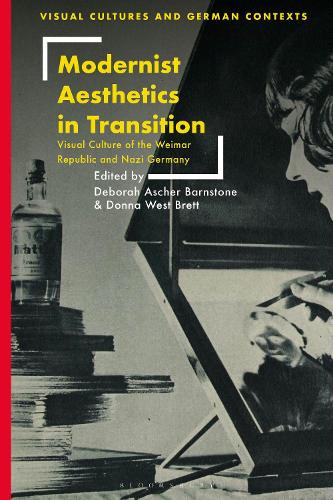
Modernist Aesthetics in Transition: Visual Culture of the Weimar Republic and Nazi Germany
(Hardback)
Publishing Details
Modernist Aesthetics in Transition: Visual Culture of the Weimar Republic and Nazi Germany
By (Author) Deborah Ascher Barnstone
Edited by Donna West Brett
Bloomsbury Publishing PLC
Bloomsbury Visual Arts
1st May 2025
United Kingdom
Classifications
Professional and Scholarly
Non Fiction
History of art
Cultural studies
LGBTQIA+ Studies / topics
701.03094309041
Physical Properties
Hardback
304
Width 158mm, Height 236mm, Spine 22mm
886g
Description
How did German aesthetic values change as the Weimar Republic fell and state Nazism began, and to what extent did they intersect with the social, cultural and political transformations of that timeContrary to conventional narratives that depict a transition away from modernity, this volume reveals that the complex artistic environment of the Weimar Republic persisted after the Nazis had taken power, despite their attempts at suppression. Illuminating the vital exchanges that occurred across multiple art forms during a period of unmatched cultural activity, this multi-disciplinary volume explores the cultural transition between Weimar- and National Socialist-era Germany and offers a fresh perspective on the fate of modernism during a time of censorship and social stigma. Featuring essays on architecture, painting, cabaret, typography, and commercial design, the volume explores competing and comparable themes across German art from 1919-1945 and addresses how modern styles like New Vision photography, Dada, and Neue Sachlichkeit coexisted with established artistic modes. By bringing this complexity to light, Modernist Aesthetics in Transition provides a deeper understanding of the complex interplay between tradition and modernity in early-20th-century Germany. Such visual complexity is evident from the volumes eclectic coverage: sexology and eroticism, visual grammar in typography and architecture, the reception of Weimar art in the National Socialist period, and the formation and transformation of queer and Jewish identities. It encompasses various subjects such as the animated films of Lotte Reininger, Gerhard Lamprecht's filmic adaptations of the 1920s, and the photography of Lszl Moholy-Nagy, Christian Schad, and the German sexologist Magnus Hirschfeld. By bridging photography, moving image, and painting, this highly interdisciplinary work provides a fresh perspective on the ever-changing art and aesthetic principles of early 20th-century Germany.
Author Bio
Deborah Ascher Barnstone is Professor and Head of the School of Architecture, Design, and Planning at the University of Sydney, Australia. She is co-editor of the Visual Cultures and German Contexts series. Donna West Brett is Associate Professor and Chair of Art History at the University of Sydney, Australia. She is author of Photography and Place: Seeing and Not Seeing Germany After 1945 (2016); and co-editor with Natalya Lusty of Photography and Ontology: Unsettling Images (2019).
